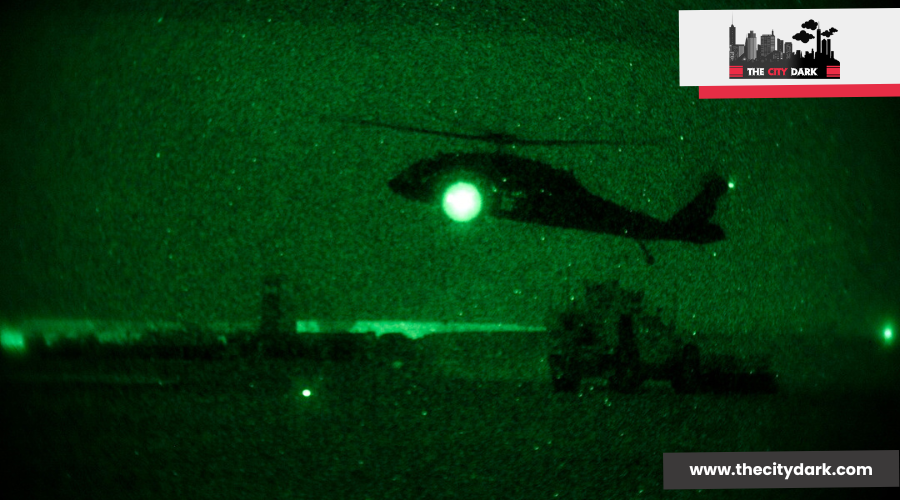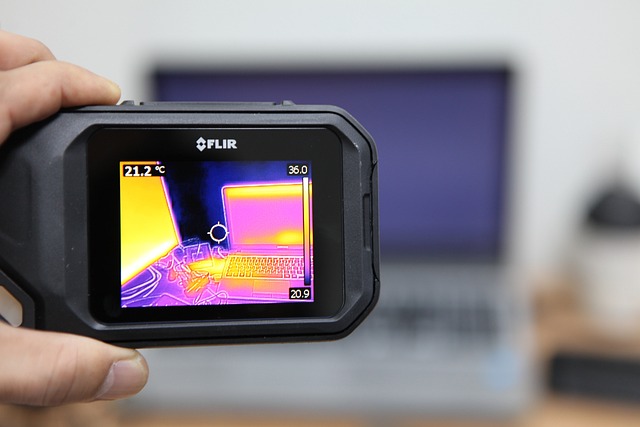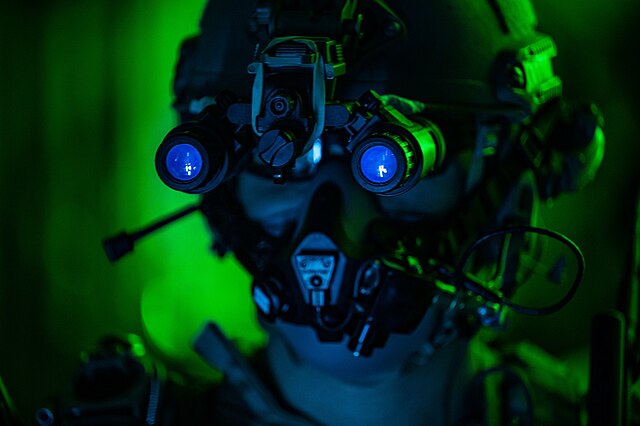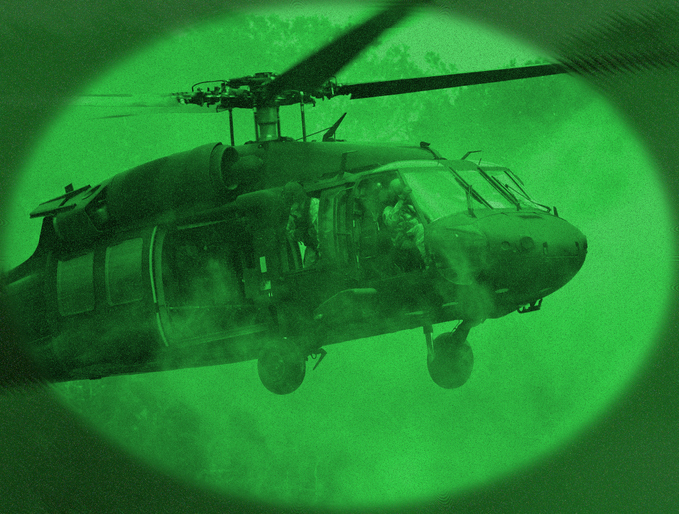Night vision redefines search and rescue operations. It lights up the night, making it easier to find people in trouble. These tools have grown smarter, using infrared and thermal tech to spot what’s hidden in darkness, improving mission success at night. You move faster, decide quicker, saving more lives by reducing wait times. Also, training helps you move safely in low light. This tech marks a significant leap, boosting your mission’s impact. Stick with us to see its transformative role in search and rescue.
Key Takeaways
- Night vision makes the dark clear, key for finding victims in search and rescue.
- Thermal imaging spots human warmth, making finding victims faster.
- It makes operations safer, aiding in navigating and deciding in the dark.
- Night vision cuts down response times, helping save lives quicker.
- New tech in night vision, including sharper sensors and smart AI, keeps making missions more effective.
Night Vision Explained
Night vision turns night into day. It makes dim light brighter to see in almost dark places. This is crucial for finding people in emergencies. Think about being lost in a thick forest or a pitch-dark cave. In these spots, regular lights fail. But night vision helps rescuers see and move in the darkest places.
Night vision works with things like image intensifier tubes and thermal sensors. These parts change invisible infrared light into images we can see. This change is important. It lets rescuers see people or dangers hidden in the dark.
These gadgets often use green. Ever notice night vision pictures are green? It’s because our eyes see more shades of green than any other color. This means we can see better detail and contrast. In emergencies, seeing small differences can help find people who are lost.
Evolution of Night Vision
Understanding night vision’s development from its early forms to today’s advanced tools sheds light on its key role in improving search and rescue missions. Beginning in World War I, night vision devices have transformed remarkably. Initially, these devices were basic, offering slight light amplification. Yet, as technology progressed, so did night vision capabilities. From Generation 0 to Generation III, each advancement enhanced light amplification and image resolution, crucial for the complexities of rescue efforts.
Today’s night vision systems, particularly those on helicopters, include infrared sensors and thermal imaging. These advancements provide high-resolution imaging and instant data processing, boosting mission efficiency. The fusion of night vision tech with avionic systems marks a significant shift, enabling precise survivor location in dim conditions. Moreover, image enhancement algorithms refine captured data, helping search and rescue teams navigate the dark more clearly and quickly. This evolution highlights night vision’s vital role in lifesaving during search and rescue missions.
Key Advantages
In your journey through the benefits of night vision in search and rescue missions, you’ll notice that better visibility at night, faster discovery of victims, and enhanced safety during operations are paramount. These benefits highlight the vital role of night vision technology in boosting the success of nighttime missions. They simplify navigation in dim conditions and ensure the rescuers’ safety while ensuring those in need are found promptly.
Enhanced Nighttime Visibility
Night vision technology significantly improves search and rescue teams’ ability to find missing persons in the dark. By increasing the light available, night vision goggles make the night easier to navigate. This technology does more than allow seeing in the dark; it enables the identification of shapes and movements that are invisible to the eye. Moreover, adding thermal imaging to night vision gear advances this capability. It detects body heat, allowing search teams to find individuals without needing light. This advancement means darkness no longer hinders quick and effective search operations, boosting the chances of mission success.
Quicker Victim Location
Utilizing night vision, search and rescue teams can swiftly find victims in darkness or dim light, significantly raising the odds of a successful rescue. This rapid discovery of victims is vital, as every moment is crucial in lifesaving efforts. Night vision’s capacity to magnify existing light and thermal imaging improves visibility, simplifying the identification of lost or endangered individuals. Thus, search and rescue missions can proceed with greater efficiency, markedly diminishing the duration of searches.
| Effect of Night Vision | Prior to Night Vision | Following Night Vision Introduction |
|---|---|---|
| Search Duration | Extended | Shortened |
| Visibility | Constrained | Augmented |
| Reaction Time | Delayed | Accelerated |
This table clearly illustrates the transformative impact of night vision technology on search and rescue operations, underscoring its essential contribution to the rapid location of victims.
Improved Operational Safety
Enhancing operational safety, night vision proves essential in search and rescue missions. It offers clear visibility in darkness, slashing accident risks. This clarity isn’t merely about seeing in the dark; it revolutionizes how rescuers understand their surroundings. With this insight, they navigate and make decisions confidently, minimizing dangers. In demanding conditions, every moment matters. Night vision guides rescue teams to swiftly and safely reach and aid those in need during night operations. Clearly, night vision stands as a vital tool for the protection of victims and rescuers alike.
Increased Efficiency
In the deep night, night vision tech boosts the efficiency of search and rescue work. It helps teams find those in need fast, under the cloak of darkness. This tool marks a leap in how well operations run, making it easier to see when light is scarce. Think of the change when teams can quickly spot missing people during night missions. This cut in waiting time isn’t just about being fast; it’s about raising survival odds for those lost or in danger.
Crossing tough landscapes like thick woods, complex caves, or areas hit by disasters feels less daunting with night vision. In darkness where old ways stumble, this tech stands out, leading rescuers to their goals with confidence. The tough reality of bad weather or hard-to-see conditions doesn’t threaten mission success as much anymore.
Improved Safety
Night vision technology marks a significant leap in safety for search and rescue efforts, giving clear sight even in pitch darkness. This technology is crucial as it enhances your ability to move through dangerous areas without falling prey to unseen hazards. With night vision, the unknown becomes visible, allowing you to see and sidestep obstacles that could threaten your mission or, more crucially, your safety.
Here’s a simplified overview of how night vision technology boosts safety in search and rescue missions:
- Clear Visibility: Ensures you can see in low light, cutting down on accidents.
- Situational Awareness: Helps navigate dangerous areas, reducing injury risks.
- Hazard Identification: Makes it easier to spot potential dangers, leading to a safer work environment.
- Enhanced Navigation: Makes moving through tough terrain easier, lowering mishap chances.
- Risk Mitigation: By improving operational capabilities, it reduces the risks involved.
In short, night vision technology transforms search and rescue operations. It not only improves visibility but also increases safety, ensuring that rescuers can carry out their tasks with an extra layer of protection against the omnipresent risks.
Higher Success Rates
Moving beyond just safer operations, night vision technology significantly raises the success of search and rescue missions. By equipping your team with this tech, you’re not merely buying gadgets; you’re boosting the core of emergency responses. Night vision offers unmatched visibility during night or low-light missions, altering the fundamentals of the game.
Consider night vision’s impact on search and rescue:
- Clear Sight in Darkness: It enables rescuers to spot missing persons swiftly in the dark, greatly increasing quick location chances.
- Sharper Awareness: Teams grasp their surroundings fully, leading to smarter, more effective search tactics.
- Enhanced Efficiency: With improved sight, rescuers navigate tough terrains with ease and speed, shortening the journey to those in need.
- Better Survival Rates: Fast identification and rescue boost the chances of survival significantly.
- Revolutionary Efficiency: Overall, night vision’s introduction greatly advances the efficiency and success of search and rescue efforts.
These transformations underscore night vision technology’s pivotal role in elevating the effectiveness of search and rescue operations, making it a game-changer in true sense.
Reduced Response Times
Night vision technology helps search and rescue teams act faster. It turns night into day, making it easier to find and help those in need. This tool means you’re not just looking into the dark; you’re seeing through it. People lost or in trouble can be found quickly, making the mission more effective.
The strength of night vision in search and rescue is clear decision-making. When time is critical, seeing well leads to quick, smart choices. This can mean the difference between life and death. Using resources wisely, it increases the chance of getting there in time.
Moreover, the faster response times thanks to night vision mean better chances of success. Quick action reduces the time to find survivors and helps save more lives. In the crucial work of search and rescue, night vision is not just helpful; it changes the game.
Applications in Rescue
Leveraging night vision’s swift capabilities transforms search and rescue missions. By harnessing infrared light, it far surpasses what visible light can do, making it a crucial tool in saving lives.
- Finding the Lost: Night vision cuts through darkness in unreachable places. This technology helps find those missing more quickly, improving rescue success rates.
- After Earthquakes: It’s vital to see heat in rubble. Night vision reveals survivors’ locations, trapped post-earthquake.
- Mountain Missions: Rough landscapes become less daunting. Night vision enhances sight, aiding rescuers in safer, more efficient missions.
- Fighting Fires: Smoke becomes less of an obstacle. Night vision guides firefighters and helicopters, speeding up victim location and extraction from fires.
- Assessing Crash Sites: Post-accident, night vision clarifies vehicle occupancy. It supports rescue and medical teams in swift action.
Night vision proves critical in modern rescue, reshaping life-saving efforts.
Training and Skills
To effectively use night vision in search and rescue, you must train hard and develop key skills. It’s not as simple as turning on a device; it’s about learning to read the subtle clues night vision reveals. As search and rescue workers, you’re stepping into a world where every shadow or heat signature might save a life. Your training will teach you to understand thermal imaging and night vision, making you a detective in the dark.
These programs are more than technical courses; they aim to improve your awareness and efficiency. You’ll learn to navigate dangerous terrains at night, perfecting your skills until you’re as comfortable in darkness as in daylight. This training isn’t just about seeing in the dark; it’s about making quick, smart decisions that can change the outcome of your missions.
Future Innovations
As we hone our skills with today’s night vision technologies, we look forward to a bright future of innovations set to transform search and rescue missions. The next era of night vision isn’t merely about vision in the dark; it’s about revolutionizing the way rescuers understand and engage with their surroundings, ensuring they can save lives more proficiently.
Here’s what the future holds for night vision technology, aiming to reshape the field:
- Multispectral systems will merge night vision with other cutting-edge technologies, offering unmatched awareness of the situation, even under the most demanding circumstances.
- The creation of comprehensive situational awareness tools will integrate night vision smoothly, providing a unified view of operations.
- The rollout of ultra-high-definition sensors in 2023 has already begun to significantly improve image quality, aiding in the easier detection and identification of targets at night.
- Artificial intelligence (AI) will enhance night vision systems by boosting image processing and recognition, thus accelerating the decision-making process.
- Ongoing collaboration among the military, law enforcement, and private sector will propel night vision technology forward, ensuring that search and rescue teams have the top-notch tools they need.
These advancements aim not just for technological dominance but for the more efficient and effective saving of lives, emphasizing the vital role of night vision in future search and rescue efforts.
Frequently Asked Questions
Why Is Night Vision Important?
Night vision is crucial. It makes us safe, helps us see animals, and improves our work. It lets us move unseen, cutting down danger. In the dark, it’s key.
What Is the Future Scope of Night Vision Technology?
The future holds for night vision: it will merge with Augmented Reality, evolve in wearable devices, empower drones autonomously, sharpen its resolution, and blend with thermal imaging. This evolution broadens its use far beyond just search and rescue.
What Is the Principle of Night Vision?
Night vision amplifies faint light or captures heat pictures. It relies on infrared and a photocathode to boost light, changing it into electronic signals, improving night sight.
What Is the Spectrum of Night Vision?
Night vision sees infrared wavelengths. It uses light amplification and thermal imaging. This makes dark places visible. The spectrum goes beyond what we can see. It makes use of thermal radiation.
Conclusion
To conclude, night vision has transformed search and rescue operations. It’s not merely about visibility in darkness; it’s about enhancing efficiency, safety, and speed. With proper training and skills, you can now face challenges that are invisible in daylight. As technology progresses, anticipate further significant breakthroughs. Night vision is more than a tool; it’s a partner in lifesaving, enabling rescues once deemed unachievable, regardless of the hour.




